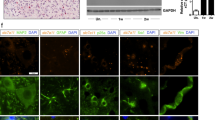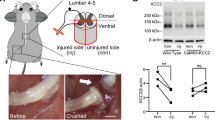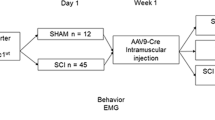Abstract
Hyperexcitability of spinal reflexes and reduced synaptic inhibition are commonly associated with spasticity after spinal cord injury (SCI). In adults, the activation of γ-aminobutyric acidA (GABAA) and glycine receptors inhibits neurons as a result of low intracellular chloride (Cl−) concentration, which is maintained by the potassium-chloride cotransporter KCC2 (encoded by Slc12a5). We show that KCC2 is downregulated after SCI in rats, particularly in motoneuron membranes, thereby depolarizing the Cl− equilibrium potential and reducing the strength of postsynaptic inhibition. Blocking KCC2 in intact rats reduces the rate-dependent depression (RDD) of the Hoffmann reflex, as is observed in spasticity. RDD is also decreased in KCC2-deficient mice and in intact rats after intrathecal brain-derived neurotrophic factor (BDNF) injection, which downregulates KCC2. The early decrease in KCC2 after SCI is prevented by sequestering BDNF at the time of SCI. Conversely, after SCI, BDNF upregulates KCC2 and restores RDD. Our results open new perspectives for the development of therapeutic strategies to alleviate spasticity.
This is a preview of subscription content, access via your institution
Access options
Subscribe to this journal
Receive 12 print issues and online access
$209.00 per year
only $17.42 per issue
Buy this article
- Purchase on Springer Link
- Instant access to full article PDF
Prices may be subject to local taxes which are calculated during checkout





Similar content being viewed by others
References
Biering-Sørensen, F., Nielsen, J.B. & Klinge, K. Spasticity-assessment: a review. Spinal Cord 44, 708–722 (2006).
Boulenguez, P. & Vinay, L. Strategies to restore motor functions after spinal cord injury. Curr. Opin. Neurobiol. 19, 587–600 (2009).
Li, Y., Gorassini, M.A. & Bennett, D.J. Role of persistent sodium and calcium currents in motoneuron firing and spasticity in chronic spinal rats. J. Neurophysiol. 91, 767–783 (2004).
Katz, R. Presynaptic inhibition in humans: a comparison between normal and spastic patients. J. Physiol. (Paris) 93, 379–385 (1999).
Mazzocchio, R. & Rossi, A. Involvement of spinal recurrent inhibition in spasticity. Further insight into the regulation of Renshaw cell activity. Brain 120, 991–1003 (1997).
Boorman, G.I., Lee, R.G., Becker, W.J. & Windhorst, U.R. Impaired 'natural reciprocal inhibition' in patients with spasticity due to incomplete spinal cord injury. Electroencephalogr. Clin. Neurophysiol. 101, 84–92 (1996).
Rémy-Néris, O., Barbeau, H., Daniel, O., Boiteau, F. & Bussel, B. Effects of intrathecal clonidine injection on spinal reflexes and human locomotion in incomplete paraplegic subjects. Exp. Brain Res. 129, 433–440 (1999).
Crone, C., Johnsen, L.L., Biering-Sorensen, F. & Nielsen, J.B. Appearance of reciprocal facilitation of ankle extensors from ankle flexors in patients with stroke or spinal cord injury. Brain 126, 495–507 (2003).
Crone, C. et al. Reduced reciprocal inhibition is seen only in spastic limbs in patients with neurolathyrism. Exp. Brain Res. 181, 193–197 (2007).
Delpire, E. & Mount, D.B. Human and murine phenotypes associated with defects in cation-chloride cotransport. Annu. Rev. Physiol. 64, 803–843 (2002).
Payne, J.A., Rivera, C., Voipio, J. & Kaila, K. Cation-chloride co-transporters in neuronal communication, development and trauma. Trends Neurosci. 26, 199–206 (2003).
Ziskind-Conhaim, L. Physiological functions of GABA-induced depolarizations in the developing rat spinal cord. Perspect. Dev. Neurobiol. 5, 279–287 (1998).
Rivera, C. et al. The K+/Cl− co-transporter KCC2 renders GABA hyperpolarizing during neuronal maturation. Nature 397, 251–255 (1999).
Hübner, C.A. et al. Disruption of KCC2 reveals an essential role of K-Cl cotransport already in early synaptic inhibition. Neuron 30, 515–524 (2001).
Cohen, I., Navarro, V., Clemenceau, S., Baulac, M. & Miles, R. On the origin of interictal activity in human temporal lobe epilepsy in vitro. Science 298, 1418–1421 (2002).
Coull, J.A. et al. Trans-synaptic shift in anion gradient in spinal lamina I neurons as a mechanism of neuropathic pain. Nature 424, 938–942 (2003).
Nabekura, J. et al. Reduction of KCC2 expression and GABAA receptor–mediated excitation after in vivo axonal injury. J. Neurosci. 22, 4412–4417 (2002).
Toyoda, H. et al. Induction of NMDA and GABAA receptor-mediated Ca2+ oscillations with KCC2 mRNA downregulation in injured facial motoneurons. J. Neurophysiol. 89, 1353–1362 (2003).
Jean-Xavier, C., Pflieger, J.-F., Liabeuf, S. & Vinay, L. Inhibitory post-synaptic potentials in lumbar motoneurons remain depolarizing after neonatal spinal cord transection in the rat. J. Neurophysiol. 96, 2274–2281 (2006).
Jean-Xavier, C., Mentis, G.Z., O'Donovan, M., Cattaert, D. & Vinay, L. Dual personality of GABA/glycine-mediated depolarizations in the immature spinal cord. Proc. Natl. Acad. Sci. USA 104, 11477–11482 (2007).
Alvarez, F.J., Dewey, D.E., Harrington, D.A. & Fyffe, R.E. Cell-type specific organization of glycine receptor clusters in the mammalian spinal cord. J. Comp. Neurol. 379, 150–170 (1997).
Jiang, Z., Carlin, K.P. & Brownstone, R.M. An in vitro functionally mature mouse spinal cord preparation for the study of spinal motor networks. Brain Res. 816, 493–499 (1999).
Wallis, D.I. & Wu, J. Fast and slow ipsilateral and contralateral spinal reflexes in the neonate rat are modulated by 5-HT. Gen. Pharmacol. 23, 1035–1044 (1992).
Edgley, S.A. & Aggelopoulos, N.C. Short latency crossed inhibitory reflex actions evoked from cutaneous afferents. Exp. Brain Res. 171, 541–550 (2006).
Thompson, F.J., Reier, P.J., Lucas, C.C. & Parmer, R. Altered patterns of reflex excitability subsequent to contusion injury of the rat spinal cord. J. Neurophysiol. 68, 1473–1486 (1992).
Grey, M.J. et al. Post-activation depression of Soleus stretch reflexes in healthy and spastic humans. Exp. Brain Res. 185, 189–197 (2008).
Woo, N.S. et al. Hyperexcitability and epilepsy associated with disruption of the mouse neuronal-specific K-Cl cotransporter gene. Hippocampus 12, 258–268 (2002).
Coull, J.A. et al. BDNF from microglia causes the shift in neuronal anion gradient underlying neuropathic pain. Nature 438, 1017–1021 (2005).
Rivera, C. et al. BDNF-induced TrkB activation down-regulates the K+-Cl− cotransporter KCC2 and impairs neuronal Cl− extrusion. J. Cell Biol. 159, 747–752 (2002).
Miletic, G. & Miletic, V. Loose ligation of the sciatic nerve is associated with TrkB receptor–dependent decreases in KCC2 protein levels in the ipsilateral spinal dorsal horn. Pain 137, 532–539 (2008).
Shulga, A. et al. Posttraumatic GABAA-mediated [Ca2+]i increase is essential for the induction of brain-derived neurotrophic factor–dependent survival of mature central neurons. J. Neurosci. 28, 6996–7005 (2008).
Yates, C. et al. The onset of hyperreflexia in the rat following complete spinal cord transection. Spinal Cord 46, 798–803 (2008).
Norton, J.A., Bennett, D.J., Knash, M.E., Murray, K.C. & Gorassini, M.A. Changes in sensory-evoked synaptic activation of motoneurons after spinal cord injury in man. Brain 131, 1478–1491 (2008).
Edgerton, V.R., Tillakaratne, N.J., Bigbee, A.J., De Leon, R.D. & Roy, R.R. Plasticity of the spinal neural circuitry after injury. Annu. Rev. Neurosci. 27, 145–167 (2004).
de Leon, R.D., Tamaki, H., Hodgson, J.A., Roy, R.R. & Edgerton, V.R. Hindlimb locomotor and postural training modulates glycinergic inhibition in the spinal cord of the adult spinal cat. J. Neurophysiol. 82, 359–369 (1999).
Edgerton, V.R. et al. Use-dependent plasticity in spinal stepping and standing. Adv. Neurol. 72, 233–247 (1997).
Stil, A. et al. Developmental up-regulation of the potassium-chloride cotransporter type 2 in the rat lumbar spinal cord. Neuroscience 164, 809–821 (2009).
Hultborn, H. et al. On the mechanism of the post-activation depression of the H-reflex in human subjects. Exp. Brain Res. 108, 450–462 (1996).
Payne, J.A. Functional characterization of the neuronal-specific K-Cl cotransporter: implications for [K+]o regulation. Am. J. Physiol. 273, C1516–C1525 (1997).
Syková, E., Jendelova, P., Svoboda, J. & Chvatal, A. Extracellular K+, pH and volume changes in spinal cord of adult rats and during postnatal development. Can. J. Physiol. Pharmacol. 70 Suppl, S301–S309 (1992).
Riekki, R. et al. Altered synaptic transmission but normal long-term plasticity in mice lacking hyperpolarizing GABAAR-mediated inhibition in CA1 pyramidal neurons. J. Neurophysiol. 99, 3075–3089 (2008).
Nakamura, M. & Bregman, B.S. Differences in neurotrophic factor gene expression profiles between neonate and adult rat spinal cord after injury. Exp. Neurol. 169, 407–415 (2001).
Li, X.L. et al. Temporal changes in the expression of some neurotrophins in spinal cord transected adult rats. Neuropeptides 41, 135–143 (2007).
Rivera, C. et al. Mechanism of activity-dependent downregulation of the neuron-specific K-Cl cotransporter KCC2. J. Neurosci. 24, 4683–4691 (2004).
Gómez-Pinilla, F. et al. BDNF and learning: evidence that instrumental training promotes learning within the spinal cord by up-regulating BDNF expression. Neuroscience 148, 893–906 (2007).
Boyce, V.S., Tumolo, M., Fischer, I., Murray, M. & Lemay, M.A. Neurotrophic factors promote and enhance locomotor recovery in untrained spinalized cats. J. Neurophysiol. 98, 1988–1996 (2007).
Lu, J., Karadsheh, M. & Delpire, E. Developmental regulation of the neuronal-specific isoform of K-Cl cotransporter KCC2 in postnatal rat brains. J. Neurobiol. 39, 558–568 (1999).
Williams, J.R., Sharp, J.W., Kumari, V.G., Wilson, M. & Payne, J.A. The neuron-specific K-Cl cotransporter, KCC2. Antibody development and initial characterization of the protein. J. Biol. Chem. 274, 12656–12664 (1999).
Blaesse, P. et al. Oligomerization of KCC2 correlates with development of inhibitory neurotransmission. J. Neurosci. 26, 10407–10419 (2006).
Acknowledgements
This study was supported by grants from the Christopher and Dana Reeve Foundation (VB1-0502-2 and VB2-0801-2 to L.V.), the French Agence Nationale pour la Recherche (to L.V.), the French Institut pour la Recherche sur la Moelle épinière et l'Encéphale (to L.V.), the US National Institutes of Health (GM074771 to E.D. and NS051644 to M.M.) and the Slovak Research and Development Agency (APVV-0314-06 to M.M.). We thank the company Pharmaxon for their help and expertise concerning SCI in rats. We also thank all team members, particularly F. Brocard, P. Coulon, K. Sadlaoud and S. Tazerart, for their assistance throughout the experiments, and F. Clarac for his support.
Author information
Authors and Affiliations
Contributions
P.B. designed and performed all in vivo experiments and some in vitro experiments (polysynaptic reflex recordings). S.L. designed and performed the immunohistochemistry, western blot and genotyping experiments. R.B. performed some in vitro experiments (RDD of the monosynaptic reflex and effects of DIOA on motoneurons). H.B. was involved in the confocal analysis and quantification of cell surface expression of KCC2. C.J.-X. contributed to the in vitro studies (EIPSP measurements). C.B., A.S. and P.D. participated in immunohistochemistry, western blot and genotyping experiments and analysis. D.C. designed the cell model used for simulations and participated in the analysis. E.D. generated the mutant mouse and provided valuable advice and expertise for KCC2 regulation. M.M. provided valuable expertise for the in vivo experiments. P.B., S.L. and L.V. wrote the manuscript. L.V. designed and supervised the whole project and contributed to the in vitro experiments, confocal analysis and simulations.
Corresponding author
Ethics declarations
Competing interests
The authors declare no competing financial interests.
Supplementary information
Supplementary Text and Figures
Supplementary Figures 1–6, Supplementary Tables 1–5 and Supplementary Methods (PDF 905 kb)
Rights and permissions
About this article
Cite this article
Boulenguez, P., Liabeuf, S., Bos, R. et al. Down-regulation of the potassium-chloride cotransporter KCC2 contributes to spasticity after spinal cord injury. Nat Med 16, 302–307 (2010). https://doi.org/10.1038/nm.2107
Received:
Accepted:
Published:
Issue Date:
DOI: https://doi.org/10.1038/nm.2107
This article is cited by
-
Neonatal inflammation increases hippocampal KCC2 expression through methylation-mediated TGF-β1 downregulation leading to impaired hippocampal cognitive function and synaptic plasticity in adult mice
Journal of Neuroinflammation (2023)
-
Testing spasticity mechanisms in chronic stroke before and after intervention with contralesional motor cortex 1 Hz rTMS and physiotherapy
Journal of NeuroEngineering and Rehabilitation (2023)
-
KCC2 downregulation after sciatic nerve injury enhances motor function recovery
Scientific Reports (2023)
-
Controlled delivery of a neurotransmitter–agonist conjugate for functional recovery after severe spinal cord injury
Nature Nanotechnology (2023)
-
Emergence of consciousness from anesthesia through ubiquitin degradation of KCC2 in the ventral posteromedial nucleus of the thalamus
Nature Neuroscience (2023)



